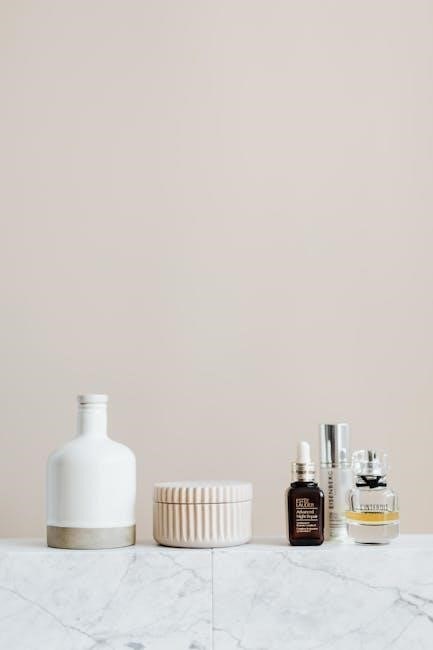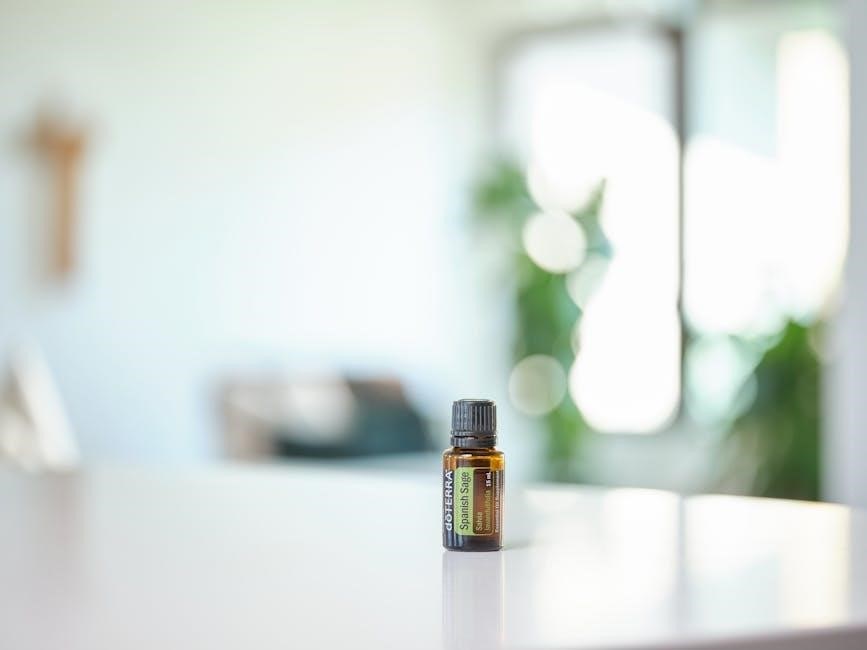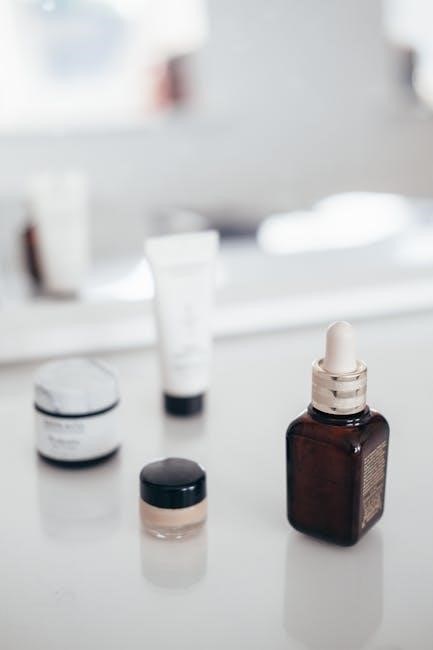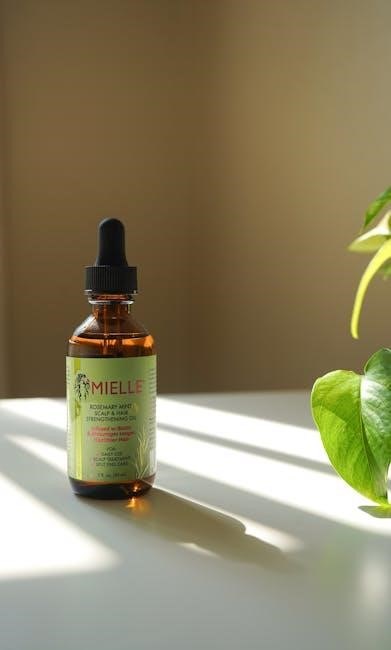Essential oils are natural, highly concentrated plant extracts with therapeutic properties. Used for centuries, they offer health, wellness, and cosmetic benefits, making them popular in aromatherapy and traditional medicine.
1.1 What Are Essential Oils?
Essential oils are concentrated plant extracts, often obtained through steam distillation or cold pressing. Composed of terpenes, alcohols, and other hydrocarbons, they capture plants’ scent and therapeutic properties. Used historically for health and wellness, they are versatile in aromatherapy, skincare, and natural remedies, offering diverse benefits for mind, body, and home.
1.2 Importance of Essential Oils
Essential oils are versatile, offering therapeutic, cosmetic, and household benefits. Their antimicrobial and anti-inflammatory properties make them valuable for health and wellness. Historically used in traditional medicine, they now play a significant role in modern holistic practices, promoting emotional well-being and natural self-care, making them indispensable in everyday life.

Popular Essential Oils and Their Uses
Essential oils like lavender, tea tree, and eucalyptus are widely used for their therapeutic benefits, offering relaxation, skin care, and natural remedies for common ailments.
2.1 Bergamot Oil
Bergamot oil, derived from citrus fruit, reduces anxiety, uplifts moods, and has antiseptic properties; Used in aromatherapy, it calms stress and enhances sleep. It’s also applied topically for skin issues and inflammation. Blending bergamot with other oils amplifies its benefits. Its fresh scent makes it popular for mood enhancement and natural remedies.
2.2 Lavender Oil
Lavender oil is renowned for its calming and soothing effects. It promotes restful sleep, reduces stress, and alleviates anxiety. Topically, it soothes burns, cuts, and skin irritations. Its gentle nature makes it suitable for all skin types. Lavender oil is also used in relaxation therapies and as a natural remedy for emotional balance and well-being.
2.3 Tea Tree Oil
Tea tree oil, known for its potent antimicrobial properties, is often used to treat acne, wounds, and fungal infections. It helps reduce inflammation, soothes skin irritations, and combats dandruff. Its versatility makes it a popular choice for natural skincare and household cleaning solutions, promoting health and hygiene effectively.
2.4 Eucalyptus Oil
Eucalyptus oil is renowned for its decongestant properties, easing respiratory issues like coughs and colds. It’s widely used in aromatherapy to refresh the mind and body; Its antiseptic qualities make it effective for wound healing and household cleaning. Diluted with carrier oils, it can soothe muscle tension and skin irritations, offering natural relief and purification.
2.5 Frankincense Oil
Frankincense oil, derived from the resin of Boswellia trees, is cherished for its anti-inflammatory and antimicrobial properties. It’s commonly used in aromatherapy to reduce stress and promote relaxation. Historically valued, frankincense oil supports skin health, eases joint pain, and enhances spiritual well-being, making it a versatile and therapeutic natural remedy for various wellness needs.
2.6 Rosemary Oil
Derived from the Rosemary plant, this oil is renowned for its cognitive and physical benefits. Known to enhance memory and focus, rosemary oil is also used to alleviate muscle aches, improve circulation, and boost mental clarity. Its invigorating scent makes it ideal for aromatherapy, promoting relaxation and improving overall well-being naturally and effectively.
2.7 Peppermint Oil
Peppermint oil, extracted from the Mentha piperita plant, is celebrated for its invigorating properties. It offers cooling relief for sore muscles and joints when applied topically. Known for its antimicrobial and anti-inflammatory benefits, peppermint oil is also used to enhance digestion, reduce nausea, and provide a refreshing, mentally stimulating aroma in aromatherapy sessions, promoting clarity and focus naturally.
2.8 Chamomile Oil
Chamomile oil, derived from Matricaria chamomilla, is renowned for its soothing and calming properties. It is commonly used to promote relaxation, improve sleep quality, and reduce stress. Chamomile oil also has anti-inflammatory and antiseptic qualities, making it effective for soothing skin irritations, calming sunburns, and addressing eczema. Its gentle nature makes it suitable for sensitive skin and babies, offering natural relief and comfort through topical application or aromatherapy.
2.9 Geranium Oil
Geranium oil, extracted from Pelargonium graveolens, is a versatile essential oil known for its floral scent and therapeutic benefits. It balances hormones, alleviates menstrual cramps, and supports skin health by reducing acne and inflammation. Geranium oil also acts as a natural insect repellent and can uplift mood, promoting emotional well-being and relaxation through aromatherapy or topical use.
2.10 Sandalwood Oil
Sandalwood oil, derived from Santalum album, is renowned for its grounding, woody aroma and therapeutic properties. It promotes relaxation, reduces anxiety, and enhances meditation; Sandalwood oil benefits skin health by reducing inflammation and acne, while its antiseptic properties support wound healing. It is also used in traditional medicine and perfumery, offering emotional and physical well-being through aromatherapy or topical application.
2.11 Clary Sage Oil
Clary sage oil, extracted from Salvia sclarea, is known for its calming and uplifting effects. It reduces stress, anxiety, and promotes relaxation. This oil is beneficial for women’s health, alleviating menstrual cramps and menopause symptoms. Clary sage also enhances skin clarity, reduces inflammation, and supports emotional well-being, making it a versatile choice in aromatherapy and natural remedies.
2.12 Cinnamon Oil
Cinnamon oil, derived from Cinnamomum verum, is a warming and stimulating essential oil. It is known for its antimicrobial and anti-inflammatory properties, making it effective for pain relief, improving circulation, and boosting digestion. Cinnamon oil also acts as a natural insect repellent and adds a warm, inviting aroma to spaces, enhancing mental clarity and focus.
2.13 Myrrh Oil
Myrrh oil, extracted from Commiphora molmol, is a resinous oil with earthy, woody scents. Historically used for its medicinal and spiritual properties, it offers anti-inflammatory and antimicrobial benefits, aiding in wound healing and skin health. Myrrh oil also supports emotional well-being, reducing stress and promoting relaxation, while its astringent properties help in oral care and hygiene.
Benefits of Essential Oils
Essential oils offer diverse benefits, including health, wellness, and beauty advantages. They provide natural remedies for physical ailments, emotional balance, and skincare, enhancing overall well-being through their therapeutic properties.
3.1 Health Benefits
Essential oils promote physical well-being by providing natural remedies for common ailments. They alleviate symptoms of colds, reduce inflammation, and support immune function. Oils like eucalyptus and peppermint offer respiratory relief, while tea tree oil has antimicrobial properties, enhancing overall health naturally without harsh chemicals, making them a popular choice for holistic health practices.
3.2 Wellness and Emotional Benefits
Essential oils offer wellness and emotional benefits, enhancing relaxation and mood naturally. Oils like lavender promote calmness and restful sleep, while bergamot uplifts spirits, reducing stress effectively. They support emotional well-being by creating a soothing atmosphere, balancing and rejuvenating the mind and body.
3.3 Beauty and Skincare Benefits
Essential oils enhance beauty and skincare routines, offering natural solutions for glowing skin. Tea tree oil combats acne, chamomile soothes irritation, and rosemary stimulates circulation. They rejuvenate skin texture, reduce inflammation, and promote healthy aging, making them versatile ingredients in cleansers, serums, and moisturizers for various skin types and concerns.
Carrier Oils: What You Need to Know
Carrier oils dilute essential oils, enhancing skin absorption and preventing irritation. Common examples include coconut, jojoba, and sweet almond oil, each offering unique benefits for skincare and wellness.
4.1 What Are Carrier Oils?
Carrier oils are non-volatile oils used to dilute essential oils, enhancing skin absorption and reducing irritation. Examples include coconut, jojoba, and sweet almond oils. They are gentle, have a longer shelf life, and are often odorless, making them ideal for blending and safely applying essential oils to the skin.
4.2 Common Carrier Oils and Their Uses
Popular carrier oils include coconut oil, known for its moisturizing properties, jojoba oil, which closely resembles skin’s natural oils, and sweet almond oil, ideal for sensitive skin. These oils are used to dilute essential oils, promote skin health, and enhance absorption, making them versatile for skincare and aromatherapy applications.
4.3 How to Use Carrier Oils with Essential Oils
Combine carrier oils with essential oils for safe application. Dilute 1-3% essential oil in the carrier oil (e.g., 5-15 drops per tablespoon). Use in massage, skincare, or bath water. Always patch test for allergies and consult guidelines for proper usage to ensure effectiveness and safety.

Historical and Traditional Uses of Essential Oils
Essential oils have been used for thousands of years in ancient civilizations, such as Egypt, China, and Greece, for perfumes, rituals, and medicines. Modern aromatherapy was founded by René-Maurice Gattefossé.
5.1 Ancient Civilizations and Essential Oils
Ancient Egypt, China, and Greece utilized essential oils in rituals, perfumes, and healing practices. Egyptians incorporated them in mummification, while Chinese used them for medicinal purposes. These early practices laid the foundation for modern aromatherapy, showcasing oils’ enduring value across cultures and centuries.
5.2 The Founding of Modern Aromatherapy
Modern aromatherapy was pioneered by French chemist René-Maurice Gattefossé in the early 20th century. His research on essential oils’ therapeutic properties, particularly after discovering lavender’s healing effects on burns, established aromatherapy as a recognized holistic practice, blending traditional knowledge with scientific evidence for health and wellness.
Practical Uses of Essential Oils
Essential oils offer versatile applications in aromatherapy, relaxation, and household cleaning. They can soothe, disinfect, and freshen spaces, while also providing natural remedies for common ailments.
6.1 Aromatherapy and Relaxation
Aromatherapy promotes relaxation and emotional well-being through essential oils. Lavender and chamomile oils reduce stress, while bergamot uplifts mood. Diffusers or topical application can create calming environments, aiding in restful sleep and mental clarity. These natural remedies offer holistic approaches to balancing mind and body for overall wellness.
6.2 Household Cleaning and Disinfection
Essential oils like eucalyptus, peppermint, and tea tree are potent natural disinfectants. They can be diluted with water or vinegar for surface cleaning, added to laundry, or used in homemade cleaning products. These oils effectively combat germs, freshen the air, and leave a refreshing scent, promoting a clean, chemical-free home environment.
6.3 Natural Remedies for Common Ailments
Essential oils offer natural solutions for common ailments. Peppermint oil eases muscle aches, while lavender soothes skin irritations. Eucalyptus oil relieves respiratory issues, and tea tree oil combats infections. These oils can be applied topically, inhaled, or added to bathwater, providing effective, chemical-free remedies for everyday health concerns.

Safety Precautions and Guidelines
Always dilute essential oils with carrier oils. Avoid sensitive areas and eyes. Patch test before use. Consult professionals for allergies or pregnancy. Ensure safe usage.
7.1 Essential Oil Safety Tips
Essential oils are potent; use them with caution. Always dilute with carrier oils before skin application. Avoid contact with eyes and sensitive areas. Patch test to check for allergies. Keep oils out of children’s reach and consult a healthcare professional before using during pregnancy or with medical conditions. Proper usage ensures safety.
7.2 Allergies and Sensitivities
Allergic reactions to essential oils can occur due to their potent nature. Common symptoms include skin irritation, itching, or rashes. Patch testing is crucial before widespread use. Oils like cinnamon or peppermint may cause sensitivities. Start with small amounts and monitor for adverse reactions. Consult a healthcare provider if severe allergies arise.
7.3 Proper Usage and Dilution
Essential oils must be used with care. Always dilute with carrier oils (1-3% concentration) to avoid skin irritation. Start with small amounts and test on a patch of skin. Use high-quality, pure oils and consult professionals for sensitive individuals or specific health conditions to ensure safe application and effectiveness.

Essential Oil Diffusers: A Complete Guide
Essential oil diffusers disperse oil particles into the air, enhancing aromatherapy benefits. They promote relaxation, improve mood, and freshen spaces naturally, making them a popular wellness tool.
8.1 What Is an Essential Oil Diffuser?
An essential oil diffuser is a device that disperses microscopic oil droplets into the air. It enhances aromatherapy by releasing fragrances and therapeutic benefits, promoting relaxation, improving mood, and purifying spaces naturally. Diffusers come in various types, including ultrasonic, nebulizing, and heat-based models, each offering unique advantages for different uses and settings.
8.2 How to Use an Essential Oil Diffuser
Filling the diffuser with water to the recommended level, add 5-10 drops of essential oil. Turn it on, and the device will release a fine mist with the oil’s fragrance and benefits. Regularly clean the device to prevent residue buildup and ensure optimal performance and longevity of the diffuser.
8.3 Different Types of Diffusers
Essential oil diffusers come in various types, including ultrasonic, nebulizing, and heat diffusers. Ultrasonic diffusers use water and mist, while nebulizing diffusers release pure oil particles. Heat diffusers are simple and effective for smaller spaces. Other options include reed and evaporative diffusers, each offering unique benefits for dispersing essential oils into the air efficiently and safely.
8.4 Blending Essential Oils for Different Effects
Blending essential oils creates unique scents and enhances their therapeutic benefits. For relaxation, combine lavender and chamomile. For energy, mix peppermint and citrus oils. Bergamot and frankincense promote mental clarity, while rosemary and eucalyptus aid focus. Blending allows customization for specific needs, such as stress relief, mood enhancement, or sleep improvement, maximizing their holistic effects effectively.
Creating Your Own Essential Oil PDF Guide
Create a comprehensive guide by listing essential oils, their benefits, and uses. Include visuals and summaries for clarity, ensuring it’s informative and easy to reference.
9.1 Steps to Make a PDF Guide
Start by researching essential oils, listing their benefits, and organizing the content. Design a layout, add visuals, and include summaries. Use a PDF creator tool to compile everything and ensure it’s visually appealing and easy to navigate for readers seeking essential oil information.
9.2 Essential Oils List with Benefits and Uses
A comprehensive PDF guide includes a detailed list of essential oils, their benefits, and uses. Popular oils like lavender promote relaxation, while tea tree oil is renowned for its antifungal properties. Eucalyptus aids respiratory issues, and peppermint boosts energy. Frankincense reduces stress, and chamomile soothes skin irritations. Bergamot uplifts mood and reduces anxiety. Each oil’s profile highlights its therapeutic value and applications.
9.3 Adding Visuals and Summaries
Enhance your PDF guide with visuals like charts, images, or infographics to illustrate essential oil benefits and uses. Summaries at the end of sections provide quick reference points, reinforcing key information. This approach ensures the guide is both informative and visually engaging, making it easier for readers to understand and apply the content effectively.

Leave a Reply
You must be logged in to post a comment.